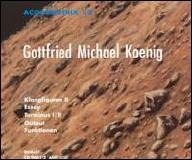During the early '60s, Koenig began writing a program -- named simply Project 1, or PR1 -- designed to compose and generate music via the computer; when in 1964 he accepted the position of creative director with the Institute for Sonology in Utrecht, Holland, he took the software with him, putting on the finishing touches three years later. While at Utrecht, Koenig also began experimenting with the Variable Function Generator, a machine developed by physics student Stan Templaars able to generate sound using roughly the same technology as an analog sequencer. Hitting upon the idea of treating the VFG as an oscillator, between 1967 and 1969 Koenig used the machine to compose a series of groundbreaking pieces known collectively as the Funktionen.
In 1968, Koenig also began work on a second program, PR2; its complicated design made it difficult to use, however, and so PR1 remained his primary outlet for computerized composition. He continued tinkering with PR1 for years to follow, in 1978 introducing VOSIM oscillators to the project to create an extended program christened PRIX; a series of subsequent additions resulted in another upgrade, PRIXM, and the completion of 1979's Output. When the Institute of Sonology was relocated to The Hague in 1986, Koenig retired from his post to focus full-time on computerized composition as well as developing new musical programs; in 1991, he also published the first in a series of theoretical writings titled Aesthetic Practice. ~ Jason Ankeny, Rovi












